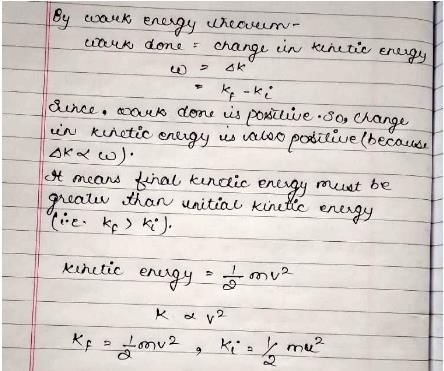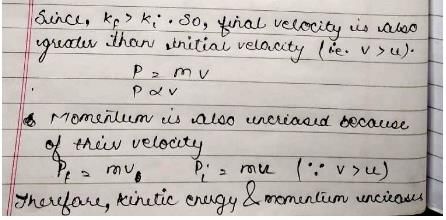All questions of Conservation of Energy for Grade 9 Exam
For what angle between Force and Displacement will the work done be positive?- a)

- b)

- c)

- d)

Correct answer is option 'C'. Can you explain this answer?
For what angle between Force and Displacement will the work done be positive?
a)
b)
c)
d)
|
|
Om Desai answered |
- If a force acting on a body has a component in the opposite direction of displacement, the work done is negative.
- So when a body slides against a rough horizontal surface, its displacement is opposite to that of the force of friction. The work done by the friction is negative.
Work done by gravitational force on a man, in lifting a bucket out of the well by rope tied to the bucket is- a)negative
- b)positive
- c)zero
- d)infinity
Correct answer is option 'A'. Can you explain this answer?
Work done by gravitational force on a man, in lifting a bucket out of the well by rope tied to the bucket is
a)
negative
b)
positive
c)
zero
d)
infinity
|
|
Om Desai answered |
When the man pulls the bucket outside the well the gravitational potential of the man + bucket system increases and hence the work done by the gravitational force is negative.
Time rate at which work is done by a force is- a)Power
- b)Torque
- c)Centrifugal Force
- d)Acceleration
Correct answer is option 'A'. Can you explain this answer?
Time rate at which work is done by a force is
a)
Power
b)
Torque
c)
Centrifugal Force
d)
Acceleration
|
|
Gaurav Kumar answered |
We know that Work done, W = F.s
where F is force and s is displacement due to that force.
Thus rate of work done is:
where F is force and s is displacement due to that force.
Thus rate of work done is:
dW/dt = d(F.s)/dt
So as F is constant we get,
dW/dt = F.d(s)/dt = F.v = P (Power)
dW/dt = F.d(s)/dt = F.v = P (Power)
By how much does kinetic energy increase if the momentum is increased by 20%?- a)55 %
- b)20 %
- c)44 %
- d)60 %
Correct answer is option 'C'. Can you explain this answer?
By how much does kinetic energy increase if the momentum is increased by 20%?
a)
55 %
b)
20 %
c)
44 %
d)
60 %
|
|
Hansa Sharma answered |
The kinetic energy is given by:
KE= p2/2m
So, ΔKE = 2pΔp / 2m = pΔp / m
ΔKE / KE = (pΔp/m) * (2m/p2) = 2Δp / p
Since the momentum p increases by 20%, so the final momentum becomes 1.2p.
Hence, KEfinal = (1.2p)2 / 2m = 1.44p2 / 2m = 1.44KE
So, % change in KE = 44%
ΔKE / KE = (pΔp/m) * (2m/p2) = 2Δp / p
Since the momentum p increases by 20%, so the final momentum becomes 1.2p.
Hence, KEfinal = (1.2p)2 / 2m = 1.44p2 / 2m = 1.44KE
So, % change in KE = 44%
Output of a truck is 4500 J and its efficiency is 50%, the input energy provided to the truck is- a)5000 J
- b)900 J
- c)9000 J
- d)500 J
Correct answer is option 'C'. Can you explain this answer?
Output of a truck is 4500 J and its efficiency is 50%, the input energy provided to the truck is
a)
5000 J
b)
900 J
c)
9000 J
d)
500 J
|
|
Naina Sharma answered |
► η = work output / heat input
► η = 50% = 50/100 = 1/2
► 1/2 = 4500 / Heat input
► Heat input = 9000 J
► η = 50% = 50/100 = 1/2
► 1/2 = 4500 / Heat input
► Heat input = 9000 J
There are two bodies X and Y with equal kinetic energy but different masses m and 4m respectively. The ratio of their linear momentum is-- a)1:2
- b)4:1
- c)1:√2
- d)1:4
Correct answer is option 'A'. Can you explain this answer?
There are two bodies X and Y with equal kinetic energy but different masses m and 4m respectively. The ratio of their linear momentum is-
a)
1:2
b)
4:1
c)
1:√2
d)
1:4
|
|
Suresh Iyer answered |
X and Y have equal kinetic energy but their masses are m and 4m respectively.
► 1/2 m1v12 = 1/2 m2v22
► mv12 = 4m * v22
► v1 : v2 = 2 : 1
Hence the ratio of their linear momentum is:
m1v1 : m2v2 = m * 2v : 4m * v = 1 : 2
► 1/2 m1v12 = 1/2 m2v22
► mv12 = 4m * v22
► v1 : v2 = 2 : 1
Hence the ratio of their linear momentum is:
m1v1 : m2v2 = m * 2v : 4m * v = 1 : 2
A machine gun fires 60 bullets per minute, with a velocity of 700 m/s. If each bullet has a mass of 50g, find the power developed by the gun.
- a)1225 W
- b)12250 W
- c)122.5 W
- d)122 W
Correct answer is option 'B'. Can you explain this answer?
A machine gun fires 60 bullets per minute, with a velocity of 700 m/s. If each bullet has a mass of 50g, find the power developed by the gun.
a)
1225 W
b)
12250 W
c)
122.5 W
d)
122 W
|
|
Tejas Verma answered |
Each bullet will have KE = 1/2 * 0.05 * 700 * 700 = 12250 J
So for 60 bullets the energy given by machine in 60 second = 60 x 12250 J
Hence power developed = Energy / time =60 x12250/60 =12250W
Or power = 12.250 kW.
So for 60 bullets the energy given by machine in 60 second = 60 x 12250 J
Hence power developed = Energy / time =60 x12250/60 =12250W
Or power = 12.250 kW.
Which of the following is not conserved in inelastic collision?- a)momentum
- b)kinetic energy
- c)both momentum and kinetic energy
- d)neither momentum nor kinetic energ
Correct answer is option 'B'. Can you explain this answer?
Which of the following is not conserved in inelastic collision?
a)
momentum
b)
kinetic energy
c)
both momentum and kinetic energy
d)
neither momentum nor kinetic energ
|
|
Rajesh Gupta answered |
In an inelastic collision, the force of reformation is not equal to the force of deformation and thus some amount of energy is lost. But still as no external force acts upon the system momentum is still conserved.
Which of the following statement is not related to conservative force?- a)Work done in closed path is zero
- b)Work done is recoverable
- c)Path independent
- d)Path dependent
Correct answer is option 'D'. Can you explain this answer?
Which of the following statement is not related to conservative force?
a)
Work done in closed path is zero
b)
Work done is recoverable
c)
Path independent
d)
Path dependent
|
|
Krishna Iyer answered |
A force is said to be conservative if the work done by or against the force on a body is independent of path followed by the body and depends only on initial and final positions.
Work done by or against the conservative force in moving a particle along a closed path is zero.
Work done by or against the conservative force in moving a particle along a closed path is zero.
Which of the following is not a unit of energy?- a)newton meter
- b)electron volt
- c)joule/meter
- d)kilowatt hour
Correct answer is option 'C'. Can you explain this answer?
Which of the following is not a unit of energy?
a)
newton meter
b)
electron volt
c)
joule/meter
d)
kilowatt hour

|
Gargey Dudhe answered |
C is correct option because energy The joule ( symbol: J) is a derived unit of energy in the International System of Units. It is equal to the energy transferred to (or work done on) an object when a force of one newton acts on that object in the direction of its motion through a distance of one metre (1 newton metreor N⋅m). pls upvote and follow me.
Two moving particle P and Q are 10 m apart at a certain instant. The velocity of P is 8m/s making an angle 30° with the line joining P and Q and that of Q is 6m/s making an angle 30° with PQ as shown in the figure. Then angular velocity of P with respect to Q is 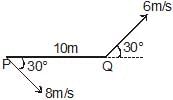
- a)Zero
- b)0.1 rad/sec
- c)0.4 rad/sec
- d)0.7 rad sec
Correct answer is option 'D'. Can you explain this answer?
Two moving particle P and Q are 10 m apart at a certain instant. The velocity of P is 8m/s making an angle 30° with the line joining P and Q and that of Q is 6m/s making an angle 30° with PQ as shown in the figure. Then angular velocity of P with respect to Q is
a)
Zero
b)
0.1 rad/sec
c)
0.4 rad/sec
d)
0.7 rad sec
|
|
Krishna Iyer answered |

A machine, in an amusement park, consists of a cage at the end of one arm, hinged at O. The cage revolves along a vertical circle of radius r (ABCDEFGH) about its hinge O, at constant linear speedv =  . The cage is so attached that the man of weight `w' standing on a weighing machine, inside the cage, is always vertical. Then which of the following is correct
. The cage is so attached that the man of weight `w' standing on a weighing machine, inside the cage, is always vertical. Then which of the following is correct
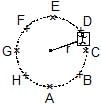
- a)The reading of his weight on the machine is the same at all positions
- b)The weight reading at A is greater than the weight reading at E by 2 w.
- c)The weight reading at G = w
- d)The ratio of the weight reading at E to that at A=0
- e)The ratio of the weight reading at A to that at C=2
Correct answer is option 'B,C,D,E'. Can you explain this answer?
A machine, in an amusement park, consists of a cage at the end of one arm, hinged at O. The cage revolves along a vertical circle of radius r (ABCDEFGH) about its hinge O, at constant linear speed
v =  . The cage is so attached that the man of weight `w' standing on a weighing machine, inside the cage, is always vertical. Then which of the following is correct
. The cage is so attached that the man of weight `w' standing on a weighing machine, inside the cage, is always vertical. Then which of the following is correct

a)
The reading of his weight on the machine is the same at all positions
b)
The weight reading at A is greater than the weight reading at E by 2 w.
c)
The weight reading at G = w
d)
The ratio of the weight reading at E to that at A=0
e)
The ratio of the weight reading at A to that at C=2

|
Crafty Classes answered |
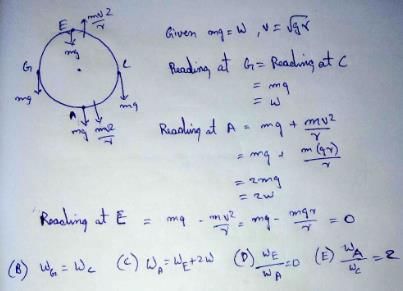
No work is done by a force on an object if- a)The force is always perpendicular to its velocity
- b)The force is always perpendicular to its acceleration
- c)The object is stationary but the point of application of the force moves on the object.
- d)The object moves in such a way that the point of application of the force remains fixed.
Correct answer is option 'A,B'. Can you explain this answer?
No work is done by a force on an object if
a)
The force is always perpendicular to its velocity
b)
The force is always perpendicular to its acceleration
c)
The object is stationary but the point of application of the force moves on the object.
d)
The object moves in such a way that the point of application of the force remains fixed.
|
|
Krishna Iyer answered |
Work done = f.ds
So on perpendicular application for product becomes zero so no work is done
So on perpendicular application for product becomes zero so no work is done
Frictional force is an example of- a)ectrostatic force
- b)Non conservative force
- c)conservative force
- d)nuclear force
Correct answer is option 'B'. Can you explain this answer?
Frictional force is an example of
a)
ectrostatic force
b)
Non conservative force
c)
conservative force
d)
nuclear force
|
|
Om Desai answered |
The friction is the phenomena that defines that there is a resistance which is present there between the two surfaces. This friction is applied tangentially to the surfaces in contact. Thus the main thing is that the forces on both of the surfaces act tangential to each other.
When conservative force does positive work on a body, the potential energy of the body:- a)increases
- b)decreases
- c)remains unaltered
- d)there is no relationship between force and potential energy
Correct answer is option 'B'. Can you explain this answer?
When conservative force does positive work on a body, the potential energy of the body:
a)
increases
b)
decreases
c)
remains unaltered
d)
there is no relationship between force and potential energy
|
|
Suresh Iyer answered |
We have a relation between potential energy and work done: 
The negative sign just shows the inverse relation between potential energy and work done by conservative force.

The negative sign just shows the inverse relation between potential energy and work done by conservative force.
Two cylindrical vessels of equal cross-sectional area 16 cm2 contain water up to heights 100 cm and 150 cm, respectively. The vessels are interconnected so that the water levels in them become equal. The work done by the force of gravity during the process is: [Take density of water = 103 kg/m3 and g = 10 ms-2]
- a)0.25 J
- b)12 J
- c)8 J
- d)1 J
Correct answer is option 'D'. Can you explain this answer?
Two cylindrical vessels of equal cross-sectional area 16 cm2 contain water up to heights 100 cm and 150 cm, respectively. The vessels are interconnected so that the water levels in them become equal. The work done by the force of gravity during the process is: [Take density of water = 103 kg/m3 and g = 10 ms-2]
a)
0.25 J
b)
12 J
c)
8 J
d)
1 J
|
|
Rajeev Saxena answered |

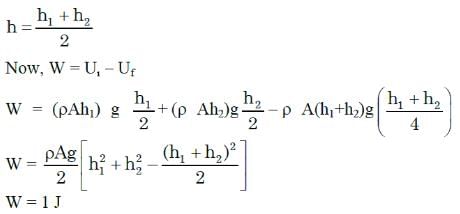
Which of the following statements is false:- a)kinetic energy is positiv
- b)potential energy is positive
- c)kinetic energy is negative
- d)potential energy is negative
Correct answer is option 'C'. Can you explain this answer?
Which of the following statements is false:
a)
kinetic energy is positiv
b)
potential energy is positive
c)
kinetic energy is negative
d)
potential energy is negative

|
Aiims answered |
K.E never negative as velocity negative then its square becomes it positive.
Select the odd one out- a)Viscous force
- b)Frictional force
- c)Electrostatic force
- d)Air-resistance
Correct answer is option 'C'. Can you explain this answer?
Select the odd one out
a)
Viscous force
b)
Frictional force
c)
Electrostatic force
d)
Air-resistance
|
|
Pranav Datta answered |
The odd one out among the given options is option 'C', which represents the Electrostatic force.
**Viscous Force:**
- Viscous force refers to the resistance that a fluid (liquid or gas) exerts on an object moving through it.
- It is a type of frictional force that opposes the relative motion of the object and the fluid.
- Viscous force is responsible for phenomena like drag experienced by objects moving through a fluid medium.
- Examples of viscous force include the resistance experienced by a car moving through air or a boat moving through water.
**Frictional Force:**
- Frictional force is the force that opposes the motion or attempted motion of an object past another object with which it is in contact.
- It arises due to the roughness or irregularities present on the surfaces in contact.
- Frictional force plays a crucial role in our daily lives, such as walking, driving a car, or holding objects.
- It can be both advantageous (e.g., walking) and disadvantageous (e.g., wearing out of machine parts).
**Electrostatic Force:**
- Electrostatic force is the force of attraction or repulsion between charged objects.
- It arises due to the electric charge carried by the objects.
- Objects with the same charges repel each other, while objects with opposite charges attract each other.
- Electrostatic force is responsible for various phenomena such as the attraction of clothes after being dried in a dryer or the repulsion of two magnets.
**Air-Resistance:**
- Air resistance, also known as drag, is a force that opposes the motion of an object through the air.
- It is caused by the collision of air molecules with the object in motion.
- Air resistance depends on factors such as the shape and size of the object, the speed of motion, and the density of the air.
- It affects objects moving through the air, like a falling parachute or a moving car.
**Explanation:**
The odd one out is electrostatic force because it is the only option that does not involve the interaction between objects in motion or with a fluid medium. Electrostatic force is related to the interaction between charged objects, whereas the other three forces (viscous force, frictional force, and air resistance) are associated with the motion of objects through a medium (fluid or air).
**Viscous Force:**
- Viscous force refers to the resistance that a fluid (liquid or gas) exerts on an object moving through it.
- It is a type of frictional force that opposes the relative motion of the object and the fluid.
- Viscous force is responsible for phenomena like drag experienced by objects moving through a fluid medium.
- Examples of viscous force include the resistance experienced by a car moving through air or a boat moving through water.
**Frictional Force:**
- Frictional force is the force that opposes the motion or attempted motion of an object past another object with which it is in contact.
- It arises due to the roughness or irregularities present on the surfaces in contact.
- Frictional force plays a crucial role in our daily lives, such as walking, driving a car, or holding objects.
- It can be both advantageous (e.g., walking) and disadvantageous (e.g., wearing out of machine parts).
**Electrostatic Force:**
- Electrostatic force is the force of attraction or repulsion between charged objects.
- It arises due to the electric charge carried by the objects.
- Objects with the same charges repel each other, while objects with opposite charges attract each other.
- Electrostatic force is responsible for various phenomena such as the attraction of clothes after being dried in a dryer or the repulsion of two magnets.
**Air-Resistance:**
- Air resistance, also known as drag, is a force that opposes the motion of an object through the air.
- It is caused by the collision of air molecules with the object in motion.
- Air resistance depends on factors such as the shape and size of the object, the speed of motion, and the density of the air.
- It affects objects moving through the air, like a falling parachute or a moving car.
**Explanation:**
The odd one out is electrostatic force because it is the only option that does not involve the interaction between objects in motion or with a fluid medium. Electrostatic force is related to the interaction between charged objects, whereas the other three forces (viscous force, frictional force, and air resistance) are associated with the motion of objects through a medium (fluid or air).
For a conservative force, F is equal to- a)

- b)

- c)

- d)

Correct answer is option 'C'. Can you explain this answer?
For a conservative force, F is equal to
a)
b)
c)
d)
|
|
Pooja Shah answered |
Potential energy at a point is defined in terms the amount of work done, which is defined in terms of force and thus we get potential as an integral of force applied over some position x. Hence F(x) = -dU(x) / dx which is the differentiation of potential energy wrt position.
If a force acts perpendicular to the direction of motion of a body, what is the amount of work done?- a)Infinity
- b)Constant
- c)Zero
- d)sinθ
Correct answer is option 'C'. Can you explain this answer?
If a force acts perpendicular to the direction of motion of a body, what is the amount of work done?
a)
Infinity
b)
Constant
c)
Zero
d)
sinθ
|
|
Anjali Sharma answered |
If a force acts perpendicular to the direction of a body, the amount of work done is zero because there is no displacement in the direction of a force.
A box of mass m is released from rest at position on the frictionless curved track shown. It slides a distance d along the track in time t to reach position 2, dropping a vertical distance h. Let v and a be the instantaneous speed and instantaneous acceleration, respectively, of the box at position 2. Which of the following equations is valid for this situation? 
- a)h = vt
- b)h = (1/2)gt2
- c)mgh = (1/2)mv2
- d)none
Correct answer is option 'C'. Can you explain this answer?
A box of mass m is released from rest at position on the frictionless curved track shown. It slides a distance d along the track in time t to reach position 2, dropping a vertical distance h. Let v and a be the instantaneous speed and instantaneous acceleration, respectively, of the box at position 2. Which of the following equations is valid for this situation?
a)
h = vt
b)
h = (1/2)gt2
c)
mgh = (1/2)mv2
d)
none

|
Imk Pathsala answered |
According to the Work Energy Theorem,
Change in PE = Change in KE
So, mgh = ½ mv2
Hence C
Forum id- 1775160
For complete circle v = √(5gl)
mgh = ½mv2
So, h = 2.5R
Change in PE = Change in KE
So, mgh = ½ mv2
Hence C
Forum id- 1775160
For complete circle v = √(5gl)
mgh = ½mv2
So, h = 2.5R
A stone of mass of 16 kg is attached to a string 144 m long and is whirled in a horizontal smooth surface. The maximum tension the string can withstand is 16 newton. The maximum speed of revolution of the stone without breaking it, will be :- a)20 ms-1
- b)16 ms-1
- c)14 ms-1
- d)12 ms-1
Correct answer is option 'A,C,D'. Can you explain this answer?
A stone of mass of 16 kg is attached to a string 144 m long and is whirled in a horizontal smooth surface. The maximum tension the string can withstand is 16 newton. The maximum speed of revolution of the stone without breaking it, will be :
a)
20 ms-1
b)
16 ms-1
c)
14 ms-1
d)
12 ms-1
|
|
Pooja Shah answered |
T= (mv2max)/r
16 = (16 v2max)/144
v2max = 12 m/s
16 = (16 v2max)/144
v2max = 12 m/s
The launching mechanism of a toy gun consists of a spring of unknown spring constant. When the spring is compressed 0.120 m, the gun, when fired vertically, is able to launch a 35.0-g projectile to a maximum height of 20.0 m above the position of the projectile before firing. Neglecting all resistive forces, determine the spring constant.- a)903 N/m
- b)993 N/m
- c)953 N/m
- d)873 N/m
Correct answer is option 'C'. Can you explain this answer?
The launching mechanism of a toy gun consists of a spring of unknown spring constant. When the spring is compressed 0.120 m, the gun, when fired vertically, is able to launch a 35.0-g projectile to a maximum height of 20.0 m above the position of the projectile before firing. Neglecting all resistive forces, determine the spring constant.
a)
903 N/m
b)
993 N/m
c)
953 N/m
d)
873 N/m

|
Mrinalini Bose answered |
Explanation:
Potential energy of spring converted in to potential energy

The minimum value of H required so that the particle makes a complete vertical circle is given by- a)5 R
- b)4 R
- c)2.5 R
- d)2 R
Correct answer is option 'C'. Can you explain this answer?
The minimum value of H required so that the particle makes a complete vertical circle is given by
a)
5 R
b)
4 R
c)
2.5 R
d)
2 R
|
|
Hansa Sharma answered |
For complete circle v = √(5gl)
mgh = ½mv2
So, h = 2.5R
mgh = ½mv2
So, h = 2.5R
The magnitude of displacement of a particle moving in a circle of radius a with constant angular speed w varies with time t as- a)2 a sin wt
- b)

- c)2a cos wt
- d)

Correct answer is option 'B'. Can you explain this answer?
The magnitude of displacement of a particle moving in a circle of radius a with constant angular speed w varies with time t as
a)
2 a sin wt
b)
c)
2a cos wt
d)
|
|
Naina Sharma answered |
If a particle is moving with angular velocity=ω
Its angle of rotation is given by ωt
Now displacement= length of line AB
Position vector of a particle is given by
R =iacosωt + jasinωt
Ro=ai
displacement =R−Ro
=a(cosωt−1)i+asinωj
d=√[(a(cosωt-1))2+(asinω)2]
=a√(2(1-cosωt))=a√(2×2(sinωt/2)2)=2asinωt/2
Its angle of rotation is given by ωt
Now displacement= length of line AB
Position vector of a particle is given by
R =iacosωt + jasinωt
Ro=ai
displacement =R−Ro
=a(cosωt−1)i+asinωj
d=√[(a(cosωt-1))2+(asinω)2]
=a√(2(1-cosωt))=a√(2×2(sinωt/2)2)=2asinωt/2
The potential energy in joules of a particle of mass 1 kg moving in a plane is given by U = 3x + 4y, the position coordinates of the point being x and y, measured in meters. If the particle is initially at rest at (6, 4), then- a)Its acceleration is of magnitude 5 m/s2
- b)Its speed when it crosses the y-axis is 10 m/s
- c)It crosses the y-axis (x = 0) at y = _4
- d)It moves in a straight line passing through the origin (0, 0)
Correct answer is option 'A,B,C'. Can you explain this answer?
The potential energy in joules of a particle of mass 1 kg moving in a plane is given by U = 3x + 4y, the position coordinates of the point being x and y, measured in meters. If the particle is initially at rest at (6, 4), then
a)
Its acceleration is of magnitude 5 m/s2
b)
Its speed when it crosses the y-axis is 10 m/s
c)
It crosses the y-axis (x = 0) at y = _4
d)
It moves in a straight line passing through the origin (0, 0)
|
|
Pooja Shah answered |
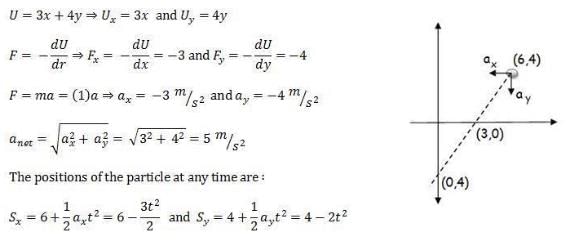
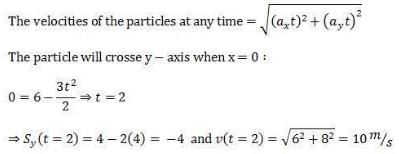 Similarly you can find that the particle crosses x - axis at (3, 0) with a velocity 7.07 m/s
Similarly you can find that the particle crosses x - axis at (3, 0) with a velocity 7.07 m/sWork done by force of friction- a)Can be zero
- b)Can be positive
- c)Can be negative
- d)Information insufficient
Correct answer is option 'A,B,C'. Can you explain this answer?
Work done by force of friction
a)
Can be zero
b)
Can be positive
c)
Can be negative
d)
Information insufficient
|
|
Om Desai answered |
Since the motion of the body can be placed in the direction of friction, opposite to the direction of motion and even can not be placed in any motion.
So, Work done by force of friction can be zero, negative, and can be positive.
So, Work done by force of friction can be zero, negative, and can be positive.
A force which does not depend on the path taken to increase the potential energy is- a)Viscous force
- b)Frictional force
- c)Conservative force
- d)Non - Conservative force
Correct answer is option 'C'. Can you explain this answer?
A force which does not depend on the path taken to increase the potential energy is
a)
Viscous force
b)
Frictional force
c)
Conservative force
d)
Non - Conservative force
|
|
Rohan Singh answered |
Gravitational and electrical forces are conservative. Friction is non-conservative because the amount of work done by friction depends on the path. One can associate a potential energy with a conservative force but not with a non-conservative force.
Work done by or against a conservative force in a round trip is- a)zero
- b)minimum
- c)maximum
- d)may be maximum or zero
Correct answer is option 'A'. Can you explain this answer?
Work done by or against a conservative force in a round trip is
a)
zero
b)
minimum
c)
maximum
d)
may be maximum or zero

|
Knowledge Hub answered |
A conservative force is a force with the property that the total work done in moving a particle between two points is independent of the taken path. Equivalently, if a particle travels in a closed loop, the total work done (the sum of the force acting along the path multiplied by the displacement) by a conservative force is zero.
A particle with constant total energy E moves in one dimension in a region where the potential energy is U(x). The speed of the particle is zero where- a) U(x) = E
- b)U(x) = 0
- c)

- d)

Correct answer is option 'A'. Can you explain this answer?
A particle with constant total energy E moves in one dimension in a region where the potential energy is U(x). The speed of the particle is zero where
a)
U(x) = E
b)
U(x) = 0
c)
d)
|
|
Neha Joshi answered |
If the total energy is E that means that E = U(x) + KE and if KE = 0 then E = U(x)
A 100000 kg engine is moving up a slope of gradient 5o at a speed of 100 m/hr. The coefficient of friction between the engine and the rails is 0.1. If the engine has an efficiency of 4% for converting heat into work, find the amount of coal, the engine has to burn up in one hour. (Burning of 1 kg of coal yields 50000 J.)- a)4.577 Kg
- b)8154 Kg
- c)91.5 Kg
- d)9154 Kg
Correct answer is option 'D'. Can you explain this answer?
A 100000 kg engine is moving up a slope of gradient 5o at a speed of 100 m/hr. The coefficient of friction between the engine and the rails is 0.1. If the engine has an efficiency of 4% for converting heat into work, find the amount of coal, the engine has to burn up in one hour. (Burning of 1 kg of coal yields 50000 J.)
a)
4.577 Kg
b)
8154 Kg
c)
91.5 Kg
d)
9154 Kg

|
EduRev NEET answered |
The forces are shown in Figure.
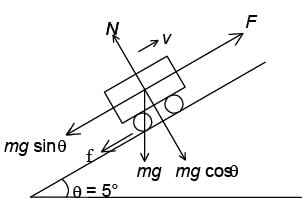
Net force to move the engine up the slope.
F = μN + mg sin θ
= mg (μ cos θ + sin θ)
If the engine has to apply an upward force equal to F, power of engine, P = Fv
where v is the velocity equal to 100 m/hr.
Work done by engine, W = Pt = Fvt
Efficiency of engine,
Energy used by engine
m = 100000 kg, μ = 0.1, θ = 5°, v = 100 m/hr, t = 1 hr
η = 4/100 = 0.04
Energy used by engine
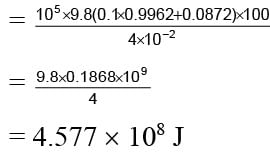
As 1 kg coal yields 50000 J, we have the amount of coal burnt up


Net force to move the engine up the slope.
F = μN + mg sin θ
= mg (μ cos θ + sin θ)
If the engine has to apply an upward force equal to F, power of engine, P = Fv
where v is the velocity equal to 100 m/hr.
Work done by engine, W = Pt = Fvt
Efficiency of engine,

Energy used by engine

m = 100000 kg, μ = 0.1, θ = 5°, v = 100 m/hr, t = 1 hr
η = 4/100 = 0.04
Energy used by engine


As 1 kg coal yields 50000 J, we have the amount of coal burnt up

Physically, the notion of potential energy is applicable only to- a)The class of forces where work done against the force gets stored up as energy.
- b)The class of forces where work done against the force gets dissipated
- c)The class of forces where work done against the force gets converted to thermal energy
- d)The class of forces where work done against the force gets converted to kinetic energy
Correct answer is option 'A'. Can you explain this answer?
Physically, the notion of potential energy is applicable only to
a)
The class of forces where work done against the force gets stored up as energy.
b)
The class of forces where work done against the force gets dissipated
c)
The class of forces where work done against the force gets converted to thermal energy
d)
The class of forces where work done against the force gets converted to kinetic energy
|
|
Mahi Nair answered |
Understanding Potential Energy
Potential energy is a crucial concept in physics that applies specifically to certain types of forces. It is essential to grasp which forces allow for the accumulation of energy based on work done against them.
Class of Forces for Potential Energy
- Definition: Potential energy is defined as the energy stored in an object due to its position or configuration.
- Work Done Against Force: The key aspect is that potential energy arises when work is done against a conservative force.
Conservative Forces
- Examples: Gravitational force and elastic force (like a spring) are classic examples of conservative forces.
- Energy Storage: When work is done against these forces, energy is stored in the system, which can later be converted back into kinetic energy or work.
Non-Conservative Forces
- Dissipative Forces: Forces such as friction or air resistance do not allow for the storage of potential energy.
- Energy Dissipation: When work is done against these forces, energy is transformed into thermal energy, not stored.
Key Takeaway
- Potential Energy Applicability: Therefore, the notion of potential energy is applicable only to the class of forces where work done against the force gets stored up as energy. This is why option 'A' is the correct choice.
Understanding these distinctions helps clarify when and how potential energy can be effectively utilized in physical systems.
Potential energy is a crucial concept in physics that applies specifically to certain types of forces. It is essential to grasp which forces allow for the accumulation of energy based on work done against them.
Class of Forces for Potential Energy
- Definition: Potential energy is defined as the energy stored in an object due to its position or configuration.
- Work Done Against Force: The key aspect is that potential energy arises when work is done against a conservative force.
Conservative Forces
- Examples: Gravitational force and elastic force (like a spring) are classic examples of conservative forces.
- Energy Storage: When work is done against these forces, energy is stored in the system, which can later be converted back into kinetic energy or work.
Non-Conservative Forces
- Dissipative Forces: Forces such as friction or air resistance do not allow for the storage of potential energy.
- Energy Dissipation: When work is done against these forces, energy is transformed into thermal energy, not stored.
Key Takeaway
- Potential Energy Applicability: Therefore, the notion of potential energy is applicable only to the class of forces where work done against the force gets stored up as energy. This is why option 'A' is the correct choice.
Understanding these distinctions helps clarify when and how potential energy can be effectively utilized in physical systems.
One end of a light spring of spring constant k is fixed to a wall and the other end is tied to a block placed on a smooth horizontal surface. In a displacement, the work done by the spring is  . The possible cases are:
. The possible cases are:- a)The spring was initially compressed by a distance x and was finally in its natural length
- b)It was initially stretched by a distance x and finally was in its natural length
- c)It was initially in its natural length and finally in a compressed position.
- d)It was initially in its natural length and finally in a stretched position.
Correct answer is option 'A,B'. Can you explain this answer?
One end of a light spring of spring constant k is fixed to a wall and the other end is tied to a block placed on a smooth horizontal surface. In a displacement, the work done by the spring is  . The possible cases are:
. The possible cases are:
a)
The spring was initially compressed by a distance x and was finally in its natural length
b)
It was initially stretched by a distance x and finally was in its natural length
c)
It was initially in its natural length and finally in a compressed position.
d)
It was initially in its natural length and finally in a stretched position.
|
|
Naina Sharma answered |
Stored elastic potential energy of spring =1/2kx2 where x is compression or elongation of spring from its natural length. In this position the spring can do work on the block tied to it, which is equal to 1/2kx2, so both option (a) & b are correct.
A person applies a constant force  on a particle of mass m and finds that the particle moves in a circle of radius r with a uniform speed v as seen (in the plane of motion) from an inertial frame of reference
on a particle of mass m and finds that the particle moves in a circle of radius r with a uniform speed v as seen (in the plane of motion) from an inertial frame of reference- a)This is not possible.
- b)There are other forces on the particle.
- c)The resultant of the other forces is
 towards the centre.
towards the centre. - d)The resultant of the other forces varies in magnitude as well as in direction.
Correct answer is option 'B,D'. Can you explain this answer?
A person applies a constant force  on a particle of mass m and finds that the particle moves in a circle of radius r with a uniform speed v as seen (in the plane of motion) from an inertial frame of reference
on a particle of mass m and finds that the particle moves in a circle of radius r with a uniform speed v as seen (in the plane of motion) from an inertial frame of reference
a)
This is not possible.
b)
There are other forces on the particle.
c)
The resultant of the other forces is  towards the centre.
towards the centre.
d)
The resultant of the other forces varies in magnitude as well as in direction.
|
|
Hansa Sharma answered |
The person applies ‘F’ constantly in a fixed direction. So, to keep the particle in constant circular motion of radius ‘r’ and uniform speed ‘v’, some other force whose resultant varies in magnitude and direction also act on the particle. Since the resultant of F and other force has to have constant magnitude but varying direction, the magnitude and direction of the other force has to change from point to point on circle.
A block of mass m slides down a plane inclined at an angle q. Which of the following will NOT increase the energy lost by the block due to friction ?- a)Increasing the angle of inclination
- b)Increasing the distance that the block travels
- c)Increasing the acceleration due to gravity
- d)Increasing the mass of the block
Correct answer is option 'A'. Can you explain this answer?
A block of mass m slides down a plane inclined at an angle q. Which of the following will NOT increase the energy lost by the block due to friction ?
a)
Increasing the angle of inclination
b)
Increasing the distance that the block travels
c)
Increasing the acceleration due to gravity
d)
Increasing the mass of the block
|
|
Akash Chakraborty answered |

The correct statement is- a)The block will cross the mean position
- b)The block come to rest when the forces acting on it are exactly balanced
- c)The block will come to rest when the work done by friction becomes equal to the change in energy stored in spring.
- d)None
Correct answer is option 'C'. Can you explain this answer?
The correct statement is
a)
The block will cross the mean position
b)
The block come to rest when the forces acting on it are exactly balanced
c)
The block will come to rest when the work done by friction becomes equal to the change in energy stored in spring.
d)
None
|
|
Upasana Roy answered |
The question is incomplete and doesn’t make sense by itself. It should be changed to:
“A spring block system is placed on a rough horizontal floor. The block is pulled towards right to give spring an elongation less than 2μmg/K but more than μmg/K and released.
The correct statement is:”
Also add this image
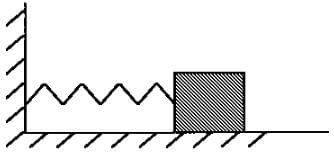
Initially the spring block system will have only one form of energy and that will be spring potential energy stored in it. After the system is released from this position it starts to oscillate to and fro with friction acting on it. When the system comes to rest then the total stored potential energy will be converted into the work done by the frictional force on the block.
“A spring block system is placed on a rough horizontal floor. The block is pulled towards right to give spring an elongation less than 2μmg/K but more than μmg/K and released.
The correct statement is:”
Also add this image

Initially the spring block system will have only one form of energy and that will be spring potential energy stored in it. After the system is released from this position it starts to oscillate to and fro with friction acting on it. When the system comes to rest then the total stored potential energy will be converted into the work done by the frictional force on the block.
A particle A moves along a circle of radius R = 50 cm so that its radius vector r relative to the point O (Fig.) rotates with the constant angular velocity w = 0.40 rad/s. Then modulus of the velocity of the particle, and the modulus of its total acceleration will be 
- a) v = 0.4 m/s, a = 0.4 m/s2
- b) v = 0.32 m/s, a = 0.32 m/s2
- c) v = 0.32 m/s, a = 0.4 m/s2
- d) v = 0.4 m/s, a = 0.32 m/s2
Correct answer is option 'D'. Can you explain this answer?
A particle A moves along a circle of radius R = 50 cm so that its radius vector r relative to the point O (Fig.) rotates with the constant angular velocity w = 0.40 rad/s. Then modulus of the velocity of the particle, and the modulus of its total acceleration will be
a)
v = 0.4 m/s, a = 0.4 m/s2
b)
v = 0.32 m/s, a = 0.32 m/s2
c)
v = 0.32 m/s, a = 0.4 m/s2
d)
v = 0.4 m/s, a = 0.32 m/s2
|
|
T.ttttt answered |
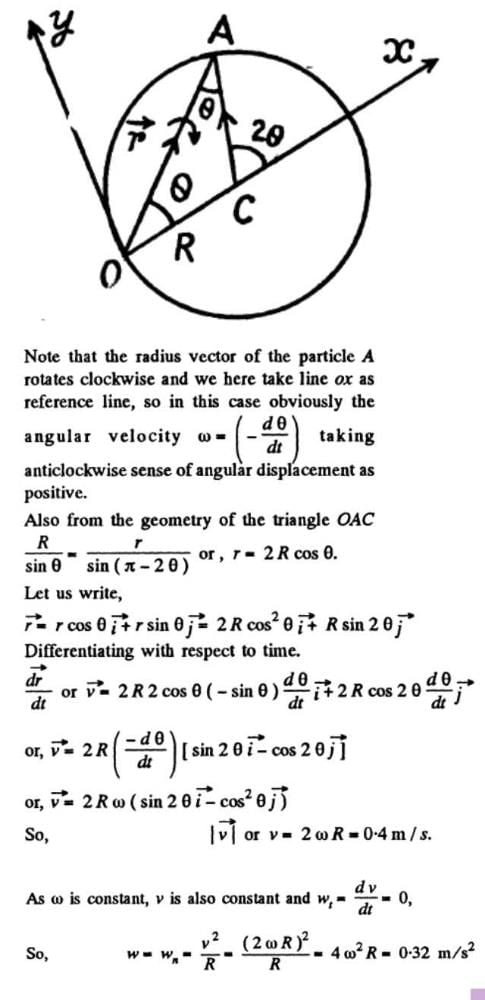
A body is slowly lowered on to a massive platform moving horizontally at a speed of 4 m/s. through what distance will the body slide relative to the platform? (The coefficient of friction is 0.2; g = 10 m/s2)- a)2 m
- b)1 m
- c)4 m
- d)10 m
Correct answer is option 'C'. Can you explain this answer?
A body is slowly lowered on to a massive platform moving horizontally at a speed of 4 m/s. through what distance will the body slide relative to the platform? (The coefficient of friction is 0.2; g = 10 m/s2)
a)
2 m
b)
1 m
c)
4 m
d)
10 m

|
Bs Academy answered |
The frictional force between the body and the platform = μmg, where m is the mass of the body.
Initially the relative velocity = 4 m/s
The relative retardation = μg
= 0.2× 10
= 2 m/s2
If S is the relative displacement before the relative velocity becomes zero, we have
0 = 42 – 2 × 2 × S
S = 16/4 = 4 m
Initially the relative velocity = 4 m/s
The relative retardation = μg
= 0.2× 10
= 2 m/s2
If S is the relative displacement before the relative velocity becomes zero, we have
0 = 42 – 2 × 2 × S
S = 16/4 = 4 m
A bolt of mass 0.3 kg falls from the ceiling of an elevator moving down with an uniform speed of 7 m/s. It hits the floor of the elevator (length of the elevator = 3 m) and does not rebound. What is the heat produced by the impact?- a)8.11 J
- b)8.42 J
- c)9.22 J
- d)8.82 J
Correct answer is option 'D'. Can you explain this answer?
A bolt of mass 0.3 kg falls from the ceiling of an elevator moving down with an uniform speed of 7 m/s. It hits the floor of the elevator (length of the elevator = 3 m) and does not rebound. What is the heat produced by the impact?
a)
8.11 J
b)
8.42 J
c)
9.22 J
d)
8.82 J
|
|
Ankita Menon answered |
Given:
Mass of the bolt (m) = 0.3 kg
Velocity of the elevator (v) = 7 m/s
Length of the elevator (L) = 3 m
To find:
Heat produced by the impact
Formula used:
The work-energy principle states that the work done on an object is equal to the change in its kinetic energy. Mathematically, it can be written as:
W = ΔKE
The kinetic energy (KE) of an object is given by:
KE = 0.5 * m * v^2
Calculation:
1. Initial kinetic energy (KEi) of the bolt before hitting the floor:
KEi = 0.5 * m * v^2
= 0.5 * 0.3 kg * (7 m/s)^2
= 0.5 * 0.3 kg * 49 m^2/s^2
= 7.35 J
2. Final kinetic energy (KEf) of the bolt after hitting the floor:
The bolt hits the floor and does not rebound, so its final velocity (vf) is 0 m/s.
Therefore, KEf = 0.5 * m * vf^2
= 0.5 * 0.3 kg * (0 m/s)^2
= 0 J
3. Change in kinetic energy (ΔKE):
ΔKE = KEf - KEi
= 0 - 7.35 J
= -7.35 J (Negative sign indicates the decrease in kinetic energy)
4. Heat produced by the impact (W):
Heat produced is equal to the work done on the bolt during the impact. Since the bolt does not rebound, all of its kinetic energy is converted into heat energy.
W = ΔKE
= -7.35 J
= 7.35 J (Magnitude is taken as heat cannot be negative)
Therefore, the heat produced by the impact is 7.35 J, which is approximately equal to 8.82 J (option D).
Mass of the bolt (m) = 0.3 kg
Velocity of the elevator (v) = 7 m/s
Length of the elevator (L) = 3 m
To find:
Heat produced by the impact
Formula used:
The work-energy principle states that the work done on an object is equal to the change in its kinetic energy. Mathematically, it can be written as:
W = ΔKE
The kinetic energy (KE) of an object is given by:
KE = 0.5 * m * v^2
Calculation:
1. Initial kinetic energy (KEi) of the bolt before hitting the floor:
KEi = 0.5 * m * v^2
= 0.5 * 0.3 kg * (7 m/s)^2
= 0.5 * 0.3 kg * 49 m^2/s^2
= 7.35 J
2. Final kinetic energy (KEf) of the bolt after hitting the floor:
The bolt hits the floor and does not rebound, so its final velocity (vf) is 0 m/s.
Therefore, KEf = 0.5 * m * vf^2
= 0.5 * 0.3 kg * (0 m/s)^2
= 0 J
3. Change in kinetic energy (ΔKE):
ΔKE = KEf - KEi
= 0 - 7.35 J
= -7.35 J (Negative sign indicates the decrease in kinetic energy)
4. Heat produced by the impact (W):
Heat produced is equal to the work done on the bolt during the impact. Since the bolt does not rebound, all of its kinetic energy is converted into heat energy.
W = ΔKE
= -7.35 J
= 7.35 J (Magnitude is taken as heat cannot be negative)
Therefore, the heat produced by the impact is 7.35 J, which is approximately equal to 8.82 J (option D).
A 60 HP electric motor lifts an elevator having a maximum total load capacity of 2000 kg. If the frictional force on the elevator is 4000 N, the speed of the elevator at full load is close to: (1 HP = 746 W, g = 10 ms-2)- a)1.5 ms-1
- b)1.9 ms-1
- c)1.7 ms-1
- d)2.0 ms-1
Correct answer is option 'B'. Can you explain this answer?
A 60 HP electric motor lifts an elevator having a maximum total load capacity of 2000 kg. If the frictional force on the elevator is 4000 N, the speed of the elevator at full load is close to: (1 HP = 746 W, g = 10 ms-2)
a)
1.5 ms-1
b)
1.9 ms-1
c)
1.7 ms-1
d)
2.0 ms-1
|
|
Sagar Choudhary answered |
Given Data
- Power of the motor: 60 HP
- Load capacity: 2000 kg
- Frictional force: 4000 N
- Acceleration due to gravity (g): 10 m/s²
- Conversion: 1 HP = 746 W
Step 1: Calculate the Power in Watts
- Total power of the motor in watts:
- 60 HP x 746 W/HP = 44760 W
Step 2: Calculate the Weight of the Elevator
- Total weight (W) of the elevator (including the load):
- W = mass x g
- W = 2000 kg x 10 m/s² = 20000 N
Step 3: Determine the Net Force Acting on the Elevator
- Net force (F_net) is calculated as:
- F_net = Power / Speed
- However, the total force also includes the frictional force:
- F_net = Weight + Friction
- F_net = 20000 N + 4000 N = 24000 N
Step 4: Calculate the Speed of the Elevator
- We know that Power = Force x Speed. Rearranging gives:
- Speed = Power / Force
- Here, Force = F_net = 24000 N
- Speed = 44760 W / 24000 N = 1.865 m/s, which rounds to approximately 1.9 m/s.
Conclusion
The speed of the elevator at full load, considering the friction, is close to 1.9 m/s, confirming that option 'B' is the correct answer.
- Power of the motor: 60 HP
- Load capacity: 2000 kg
- Frictional force: 4000 N
- Acceleration due to gravity (g): 10 m/s²
- Conversion: 1 HP = 746 W
Step 1: Calculate the Power in Watts
- Total power of the motor in watts:
- 60 HP x 746 W/HP = 44760 W
Step 2: Calculate the Weight of the Elevator
- Total weight (W) of the elevator (including the load):
- W = mass x g
- W = 2000 kg x 10 m/s² = 20000 N
Step 3: Determine the Net Force Acting on the Elevator
- Net force (F_net) is calculated as:
- F_net = Power / Speed
- However, the total force also includes the frictional force:
- F_net = Weight + Friction
- F_net = 20000 N + 4000 N = 24000 N
Step 4: Calculate the Speed of the Elevator
- We know that Power = Force x Speed. Rearranging gives:
- Speed = Power / Force
- Here, Force = F_net = 24000 N
- Speed = 44760 W / 24000 N = 1.865 m/s, which rounds to approximately 1.9 m/s.
Conclusion
The speed of the elevator at full load, considering the friction, is close to 1.9 m/s, confirming that option 'B' is the correct answer.
A 50.0-kg marathon runner runs up the stairs to the top of a 443-m-tall Tower. To lift herself to the top in 15.0 minutes, what must be her average power output?- a)241 W
- b)201 W
- c)221 W
- d)261 W
Correct answer is option 'A'. Can you explain this answer?
A 50.0-kg marathon runner runs up the stairs to the top of a 443-m-tall Tower. To lift herself to the top in 15.0 minutes, what must be her average power output?
a)
241 W
b)
201 W
c)
221 W
d)
261 W
|
|
Nishanth Saini answered |
Understanding the Problem
To find the average power output of the marathon runner, we need to calculate the work done against gravity and then divide it by the time taken.
Step 1: Calculate the Work Done
- The work done (W) against gravity can be calculated using the formula:
- W = m * g * h
- Where:
- m = mass of the runner = 50.0 kg
- g = acceleration due to gravity = 9.81 m/s²
- h = height of the tower = 443 m
- Substituting the values:
- W = 50.0 kg * 9.81 m/s² * 443 m
- W ≈ 217,791.5 J (joules)
Step 2: Calculate the Time Taken
- The time taken (t) is given as 15.0 minutes, which we need to convert into seconds:
- t = 15.0 min * 60 s/min = 900 s
Step 3: Calculate Average Power Output
- Average power (P) can be calculated using the formula:
- P = W / t
- Substituting the values:
- P = 217,791.5 J / 900 s
- P ≈ 241 W (watts)
Conclusion
Thus, the average power output of the marathon runner while running up the stairs to the top of the tower is approximately 241 watts, which corresponds to option 'A'. This value reflects the energy expended per unit time while performing the work of lifting her own body weight against gravity.
To find the average power output of the marathon runner, we need to calculate the work done against gravity and then divide it by the time taken.
Step 1: Calculate the Work Done
- The work done (W) against gravity can be calculated using the formula:
- W = m * g * h
- Where:
- m = mass of the runner = 50.0 kg
- g = acceleration due to gravity = 9.81 m/s²
- h = height of the tower = 443 m
- Substituting the values:
- W = 50.0 kg * 9.81 m/s² * 443 m
- W ≈ 217,791.5 J (joules)
Step 2: Calculate the Time Taken
- The time taken (t) is given as 15.0 minutes, which we need to convert into seconds:
- t = 15.0 min * 60 s/min = 900 s
Step 3: Calculate Average Power Output
- Average power (P) can be calculated using the formula:
- P = W / t
- Substituting the values:
- P = 217,791.5 J / 900 s
- P ≈ 241 W (watts)
Conclusion
Thus, the average power output of the marathon runner while running up the stairs to the top of the tower is approximately 241 watts, which corresponds to option 'A'. This value reflects the energy expended per unit time while performing the work of lifting her own body weight against gravity.
In an Inelastic Collision,- a)the total kinetic energy of the system is the same after the collision as before
- b)the total kinetic energy of the system is the zero after the collision.
- c)the total kinetic energy after the collision is less than before the collision
- d)the total kinetic energy of the system is greater than the total kinetic energy before
Correct answer is option 'C'. Can you explain this answer?
In an Inelastic Collision,
a)
the total kinetic energy of the system is the same after the collision as before
b)
the total kinetic energy of the system is the zero after the collision.
c)
the total kinetic energy after the collision is less than before the collision
d)
the total kinetic energy of the system is greater than the total kinetic energy before
|
|
Isha Khanna answered |
Understanding Inelastic Collisions
Inelastic collisions are a fundamental concept in physics, particularly in mechanics. Here's an explanation of why the correct answer is option 'C'.
Definition of Inelastic Collision
- An inelastic collision occurs when two objects collide and stick together or deform.
- Unlike elastic collisions, kinetic energy is not conserved in inelastic collisions.
Total Kinetic Energy Before and After
- In an inelastic collision, the total kinetic energy of the system after the collision is less than the total kinetic energy before the collision.
- This loss of kinetic energy is transformed into other forms of energy, such as heat, sound, or deformation of the colliding bodies.
Why Option 'C' is Correct
- Kinetic energy is a measure of motion. During an inelastic collision, some of this energy is lost due to factors like:
- Deformation of the objects
- Generation of heat
- Sound produced during the collision
- Therefore, option 'C' accurately states that the total kinetic energy after the collision is less than before.
Examples of Inelastic Collisions
- Car accidents where vehicles crumple upon impact.
- A football colliding with a player’s foot and losing speed after the kick.
Conclusion
In summary, inelastic collisions result in a decrease in the total kinetic energy of the system, making option 'C' the correct choice. Understanding this concept is crucial for solving problems related to momentum and energy in physics, especially in contexts like NEET examinations.
Inelastic collisions are a fundamental concept in physics, particularly in mechanics. Here's an explanation of why the correct answer is option 'C'.
Definition of Inelastic Collision
- An inelastic collision occurs when two objects collide and stick together or deform.
- Unlike elastic collisions, kinetic energy is not conserved in inelastic collisions.
Total Kinetic Energy Before and After
- In an inelastic collision, the total kinetic energy of the system after the collision is less than the total kinetic energy before the collision.
- This loss of kinetic energy is transformed into other forms of energy, such as heat, sound, or deformation of the colliding bodies.
Why Option 'C' is Correct
- Kinetic energy is a measure of motion. During an inelastic collision, some of this energy is lost due to factors like:
- Deformation of the objects
- Generation of heat
- Sound produced during the collision
- Therefore, option 'C' accurately states that the total kinetic energy after the collision is less than before.
Examples of Inelastic Collisions
- Car accidents where vehicles crumple upon impact.
- A football colliding with a player’s foot and losing speed after the kick.
Conclusion
In summary, inelastic collisions result in a decrease in the total kinetic energy of the system, making option 'C' the correct choice. Understanding this concept is crucial for solving problems related to momentum and energy in physics, especially in contexts like NEET examinations.
Find the potential energy stored in a ball of mass 5 kg placed at a height of 3 m above the ground.- a)121.20 J
- b)227.31 J
- c)147.15 J
- d)182.21 J
Correct answer is option 'C'. Can you explain this answer?
Find the potential energy stored in a ball of mass 5 kg placed at a height of 3 m above the ground.
a)
121.20 J
b)
227.31 J
c)
147.15 J
d)
182.21 J
|
|
Mira Joshi answered |
m = 5 kg,
h = 3 m,
g = 9.81 m/s-2
h = 3 m,
g = 9.81 m/s-2
We know that,
Potential energy = mgh
Potential energy = mgh
= 5 * 9.81 * 3 = 147.15 J
Hence, the correct answer is Option C.
At time t = 0 s particle starts moving along the x-axis. If its kinetic energy increases uniformly with time ‘t’, the net force acting on it must be proportional to- a) √t
- b) 1/√t
- c)constant
- d)t
Correct answer is option 'B'. Can you explain this answer?
At time t = 0 s particle starts moving along the x-axis. If its kinetic energy increases uniformly with time ‘t’, the net force acting on it must be proportional to
a)
√t
b)
1/√t
c)
constant
d)
t
|
|
Sinjini Choudhury answered |
, then its acceleration is also constant. We can use the following kinematic equation to relate the acceleration, time, initial velocity, and displacement:
x = x0 + v0*t + (1/2)*a*t^2
where x is the displacement, x0 is the initial position (assumed to be zero), v0 is the initial velocity, t is the time, and a is the acceleration.
Since the kinetic energy increases uniformly with time, we can assume that the acceleration is also constant. Let's call this acceleration a. Then, the velocity at time t is:
v(t) = v0 + a*t
The kinetic energy is given by:
KE = (1/2)*m*v^2
where m is the mass of the particle.
Since the kinetic energy increases uniformly with time, we can write:
dKE/dt = constant
Taking the derivative with respect to time, we get:
dKE/dt = m*v*(dv/dt)
Substituting v(t) and dv/dt = a, we get:
dKE/dt = m*(v0 + a*t)*a
Since dKE/dt is constant, we can write:
dKE/dt = m*a*(v0 + a*t) = constant
Solving for a, we get:
a = constant/dt
where dt is a small time interval.
Now, we can use the kinematic equation to find the displacement x at time t:
x = (1/2)*a*t^2 + v0*t
Substituting a = constant/dt and v0 = 0, we get:
x = (1/2)*(constant/dt)*t^2
Simplifying, we get:
x = (constant/2)*t
Therefore, the particle moves with a constant velocity given by:
v = dx/dt = constant/2
This means that the velocity increases linearly with time, and the displacement increases quadratically with time.
x = x0 + v0*t + (1/2)*a*t^2
where x is the displacement, x0 is the initial position (assumed to be zero), v0 is the initial velocity, t is the time, and a is the acceleration.
Since the kinetic energy increases uniformly with time, we can assume that the acceleration is also constant. Let's call this acceleration a. Then, the velocity at time t is:
v(t) = v0 + a*t
The kinetic energy is given by:
KE = (1/2)*m*v^2
where m is the mass of the particle.
Since the kinetic energy increases uniformly with time, we can write:
dKE/dt = constant
Taking the derivative with respect to time, we get:
dKE/dt = m*v*(dv/dt)
Substituting v(t) and dv/dt = a, we get:
dKE/dt = m*(v0 + a*t)*a
Since dKE/dt is constant, we can write:
dKE/dt = m*a*(v0 + a*t) = constant
Solving for a, we get:
a = constant/dt
where dt is a small time interval.
Now, we can use the kinematic equation to find the displacement x at time t:
x = (1/2)*a*t^2 + v0*t
Substituting a = constant/dt and v0 = 0, we get:
x = (1/2)*(constant/dt)*t^2
Simplifying, we get:
x = (constant/2)*t
Therefore, the particle moves with a constant velocity given by:
v = dx/dt = constant/2
This means that the velocity increases linearly with time, and the displacement increases quadratically with time.
Tangential acceleration of a particle moving in a circle of radius 1 m varies with time t as (initial velocity of particle is zero). Time after which total cceleration of particle makes and angle of 30º with radial acceleration is 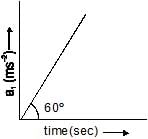
- a)4 sec
- b)4/3 sec
- c)22/3 sec
- d)

Correct answer is option 'C'. Can you explain this answer?
Tangential acceleration of a particle moving in a circle of radius 1 m varies with time t as (initial velocity of particle is zero). Time after which total cceleration of particle makes and angle of 30º with radial acceleration is
a)
4 sec
b)
4/3 sec
c)
22/3 sec
d)

|
Niladrita Chakraborty answered |
I think this ans is incorrect
A cart moves with a constant speed along a horizontal circular path. From the cart, a particle is thrown up vertically with respect to the cart- a)The particle will land somewhere on the circular path
- b)The particle will land outside the circular path
- c)The particle will follow an elliptical path
- d)The particle will follow a parabolic path
Correct answer is option 'B,D'. Can you explain this answer?
A cart moves with a constant speed along a horizontal circular path. From the cart, a particle is thrown up vertically with respect to the cart
a)
The particle will land somewhere on the circular path
b)
The particle will land outside the circular path
c)
The particle will follow an elliptical path
d)
The particle will follow a parabolic path
|
|
Arka Desai answered |
The particle will land outside the circle because its initial velocity in horizontal direction is in the tangential direction and its point of projection is somewhere at the circumference of the circle.
Also its path will be parabolic because it is a case of projectile motion with velocity in horizontal as well as vertical direction.
Also its path will be parabolic because it is a case of projectile motion with velocity in horizontal as well as vertical direction.
A ball of mass m is attached to the lower end of light vertical spring of force constant k. The upper end of the spring is fixed. The ball is released from rest with the spring at its normal (unstreched) length, comes to rest again after descending through a distance x.- a) x = mg/k
- b) x = 2 mg/k
- c)The ball will have no acceleration at the position where it has descended through x/2.
- d)The ball will have an upward acceleration equal to g at its lowermost position.
Correct answer is option 'B,C,D'. Can you explain this answer?
A ball of mass m is attached to the lower end of light vertical spring of force constant k. The upper end of the spring is fixed. The ball is released from rest with the spring at its normal (unstreched) length, comes to rest again after descending through a distance x.
a)
x = mg/k
b)
x = 2 mg/k
c)
The ball will have no acceleration at the position where it has descended through x/2.
d)
The ball will have an upward acceleration equal to g at its lowermost position.
|
|
Sparsh Datta answered |
The ball is at rest, it has maximum potential energy. When the ball is released from rest with the spring at its normal (unstretched) length it loses some potential energy and energy of spring increases. Hence, loss in potential energy of the ball is equal to gain in potential energy of spring.
∴mgx=1/2kx2
∴x=2mg/k
Also, for x′=x/2,
kx′=mg i.e. forces are equal thus, the ball will have no acceleration at the position where it has descended through 2x.
And when ball is at lowermost position, the spring force will be
kx=2mg
Hence, the ball will have an upward acceleration equal to g at its lowermost position.
∴mgx=1/2kx2
∴x=2mg/k
Also, for x′=x/2,
kx′=mg i.e. forces are equal thus, the ball will have no acceleration at the position where it has descended through 2x.
And when ball is at lowermost position, the spring force will be
kx=2mg
Hence, the ball will have an upward acceleration equal to g at its lowermost position.
A spot light S rotates in a horizontal plane with a constant angular velocity of 0.1 rad/s. The spot of light p moves along the wall at a distance 3 m. What is the velocity of the spot P when q = 45° ? 
- a)0.6 m/s
- b) 0.5 m/s
- c)0.4 m/s
- d) 0.3 m/s
Correct answer is option 'A'. Can you explain this answer?
A spot light S rotates in a horizontal plane with a constant angular velocity of 0.1 rad/s. The spot of light p moves along the wall at a distance 3 m. What is the velocity of the spot P when q = 45° ?
a)
0.6 m/s
b)
0.5 m/s
c)
0.4 m/s
d)
0.3 m/s

|
Crafty Classes answered |
Linear Velocity of rotating object ν=ωr/sinθ
ω= angular velocity=0.1 rad/s
r is the distance of object from centre.
Angle = 45o
r = d/cosθ [where d is the distance from the spot light to wall] = 3/cos45o
Velocity = ν = ωr/sinθ
= [0.1x3/cos45degree]/sin45degree
= 0.1x3/sin45 degreecos45degree
= 0.3/[1√2 x 1 /2]
= 2x0.3
= 0.6m/s
The velocity of the spot P is 0.6 m/s
ω= angular velocity=0.1 rad/s
r is the distance of object from centre.
Angle = 45o
r = d/cosθ [where d is the distance from the spot light to wall] = 3/cos45o
Velocity = ν = ωr/sinθ
= [0.1x3/cos45degree]/sin45degree
= 0.1x3/sin45 degreecos45degree
= 0.3/[1√2 x 1 /2]
= 2x0.3
= 0.6m/s
The velocity of the spot P is 0.6 m/s
Chapter doubts & questions for Conservation of Energy - Physics 2025 is part of Grade 9 exam preparation. The chapters have been prepared according to the Grade 9 exam syllabus. The Chapter doubts & questions, notes, tests & MCQs are made for Grade 9 2025 Exam. Find important definitions, questions, notes, meanings, examples, exercises, MCQs and online tests here.
Chapter doubts & questions of Conservation of Energy - Physics in English & Hindi are available as part of Grade 9 exam.
Download more important topics, notes, lectures and mock test series for Grade 9 Exam by signing up for free.
Physics
307 videos|482 docs|202 tests
|

Contact Support
Our team is online on weekdays between 10 AM - 7 PM
Typical reply within 3 hours
|
Free Exam Preparation
at your Fingertips!
Access Free Study Material - Test Series, Structured Courses, Free Videos & Study Notes and Prepare for Your Exam With Ease

 Join the 10M+ students on EduRev
Join the 10M+ students on EduRev
|

|
Create your account for free
OR
Forgot Password
OR
Signup to see your scores
go up
within 7 days!
within 7 days!
Takes less than 10 seconds to signup

